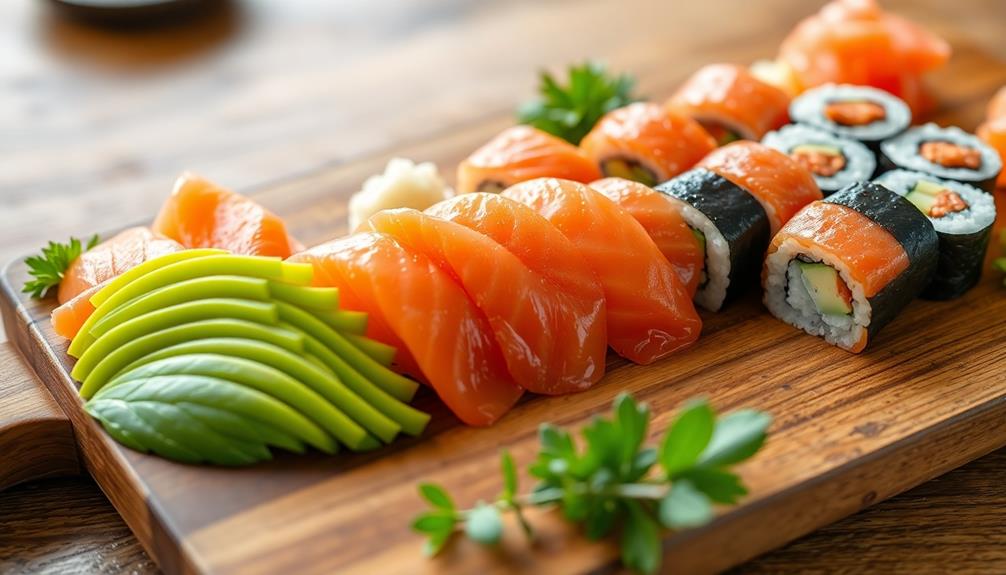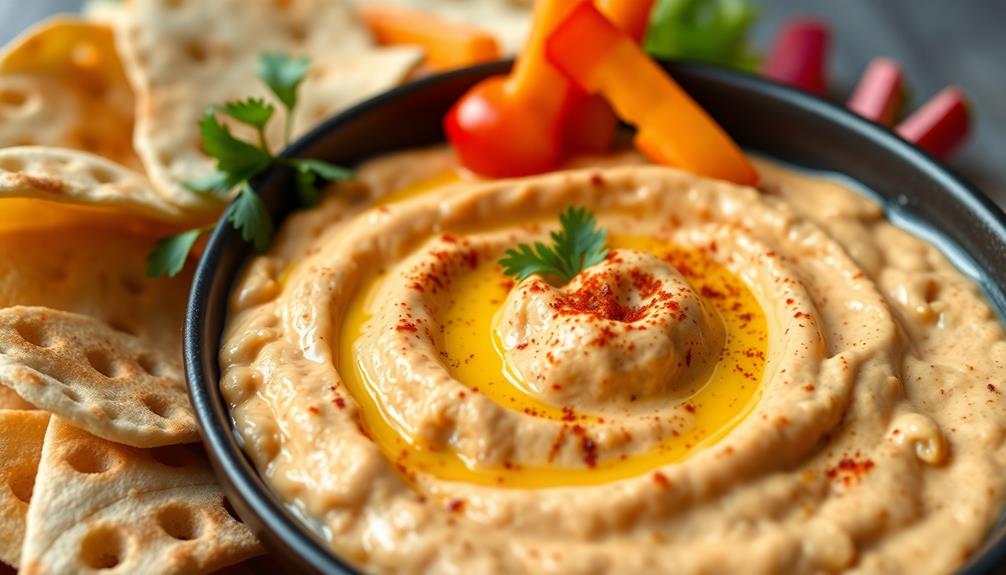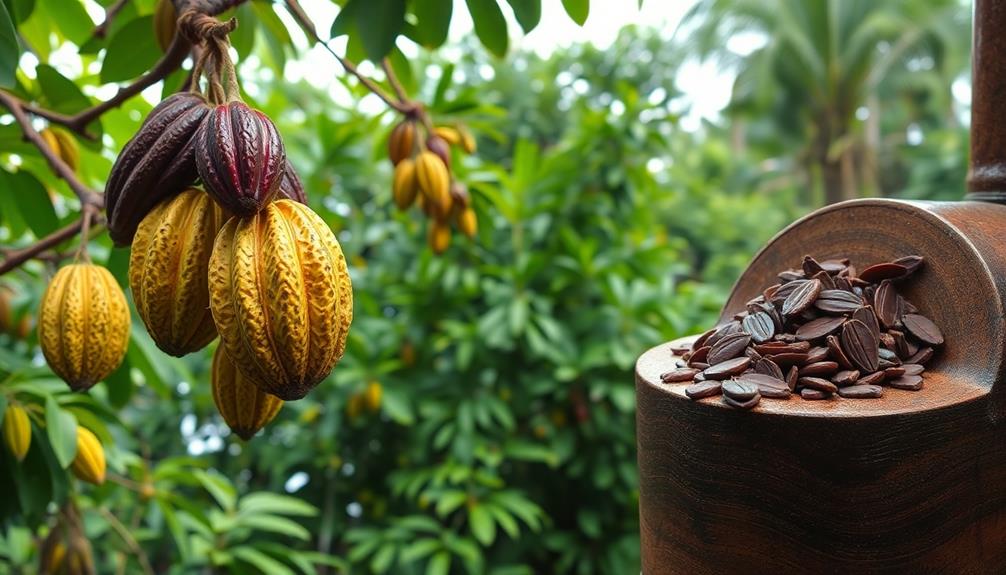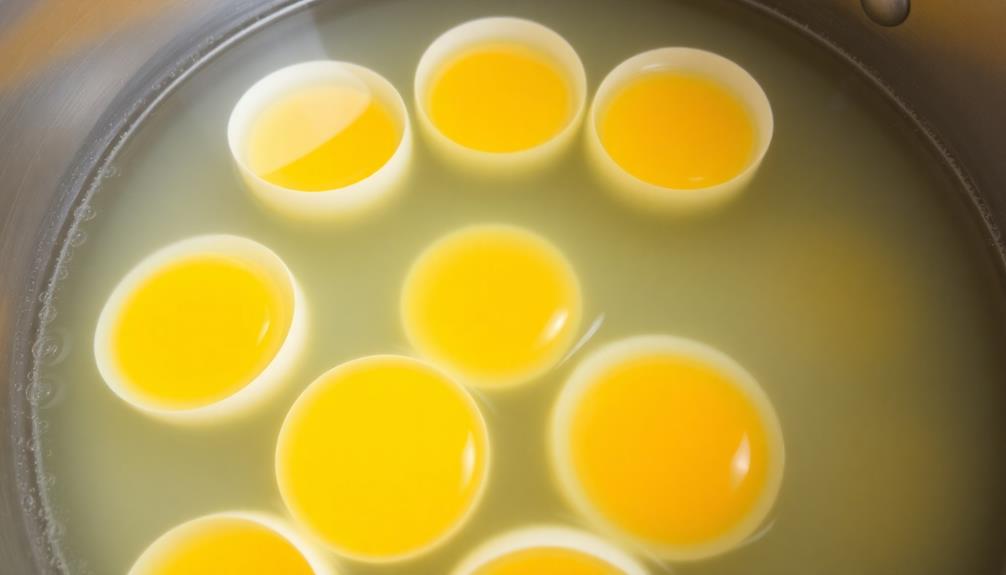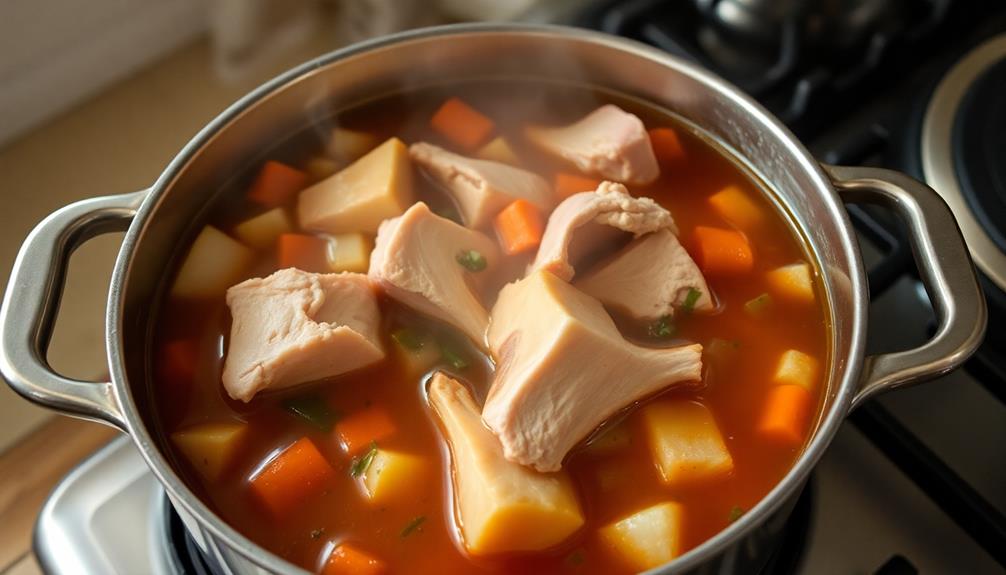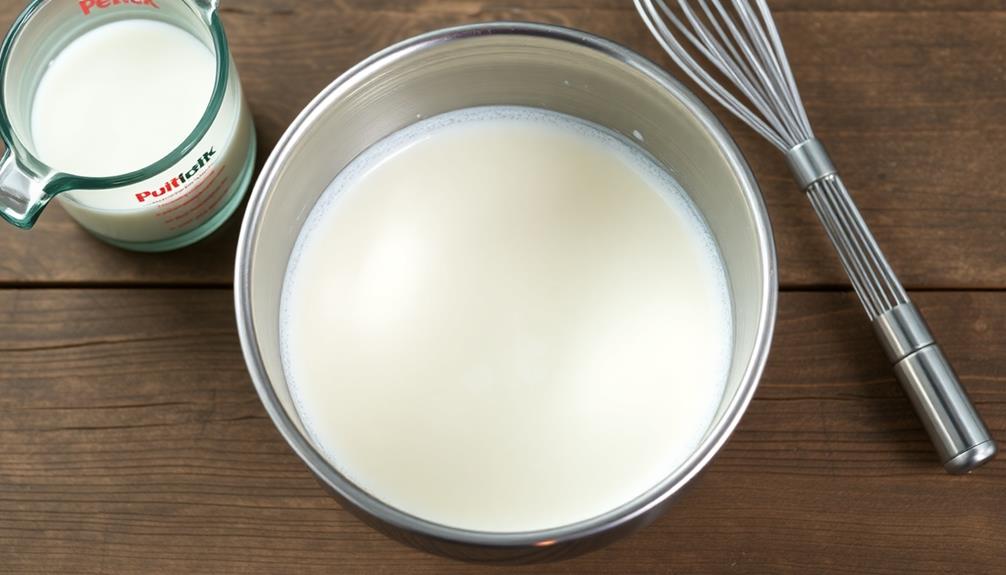Unlock the secrets of authentic Japanese sushi-making right in your own kitchen! Explore sushi's rich history, from its ancient origins as a fish preservation method to its modern popularity. Master the key ingredients – sushi rice, nori seaweed, and the freshest fish – to craft nigiri, maki rolls, and temaki hand rolls. Hone your skills with precise cutting techniques and proper rolling methods using a bamboo mat. Elevate your creations with the perfect condiments like soy sauce and wasabi. Whether you're a sushi aficionado or a curious home cook, this comprehensive guide will have you rolling, slicing, and savoring homemade sushi that rivals the best restaurants. Continue reading to discover the full culinary journey.
Key Takeaways
- Source high-quality, fresh sushi-grade ingredients, including short-grain Japanese rice, premium nori seaweed sheets, and fresh, sustainable seafood.
- Master the proper sushi rice preparation techniques, including seasoning with rice vinegar, sugar, and salt for optimal texture and taste.
- Utilize a bamboo mat to skillfully roll sushi, ensuring uniform shape and structural integrity of the rolls.
- Slice fish fillets into thin, uniform pieces against the grain for a tender, melt-in-your-mouth texture.
- Serve sushi with traditional accompaniments like soy sauce, wasabi, and pickled ginger to complement the flavors and enhance the overall dining experience.
History

The origins of sushi can be traced back to ancient Japan, where it emerged as a preservation method for fresh fish. This centuries-old tradition involved fermenting fish with rice and salt, creating a nutritious and long-lasting food source.
Over time, the fermentation process was shortened, and the rice vinegar was introduced to add a tangy flavor.
Sushi's popularity grew in the 18th century, as it became a street food enjoyed by the masses. The iconic nigiri-style sushi, featuring hand-pressed rice topped with fresh fish, was popularized by Hanaya Yohei, a skilled sushi chef who opened his famous shop in Tokyo.
This innovation paved the way for the diverse sushi styles we know and love today, from maki rolls to temaki hand rolls.
As sushi's global popularity has soared, the art of crafting authentic, high-quality sushi has become increasingly valued. Mastering sushi-making at home allows you to recreate the flavors and traditions of this beloved Japanese cuisine.
Recipe
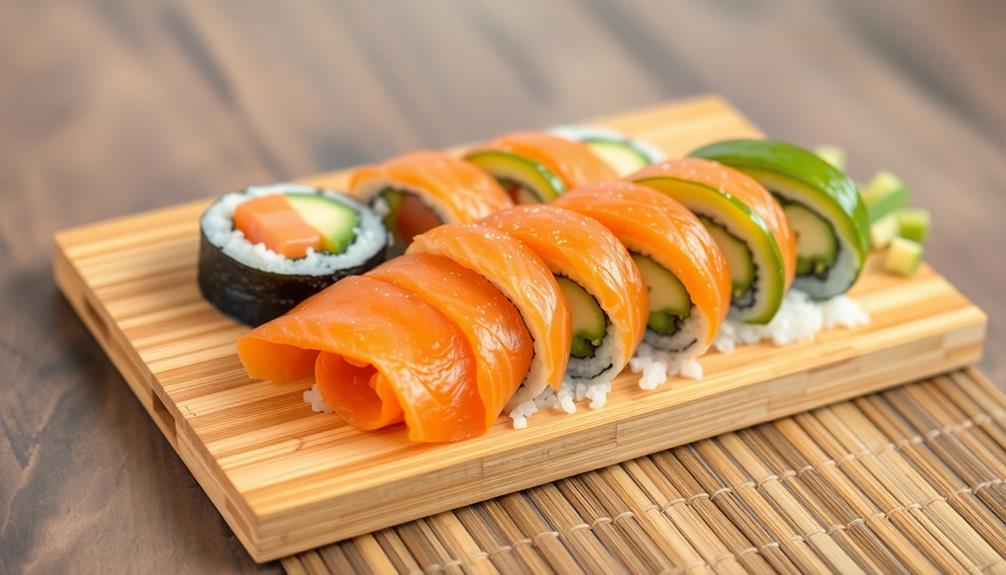
Sushi is a delicate and intricate Japanese dish that has captivated the culinary world. While traditionally prepared by skilled sushi chefs, it's possible to recreate authentic sushi at home with the right techniques and ingredients. This recipe will guide you through the process of making delectable sushi that will impress your family and friends.
The key to successful sushi-making lies in the preparation of the rice. Sushi rice is a specific type of short-grain rice that's seasoned with a mixture of rice vinegar, sugar, and salt. Achieving the perfect texture and flavor of the rice is crucial to the overall success of your sushi.
- Sushi rice
- Nori seaweed sheets
- Assorted fresh fish (such as tuna, salmon, or yellowtail)
- Avocado
- Cucumber
- Wasabi
- Soy sauce
- Rice vinegar
- Sugar
- Salt
Begin by cooking the sushi rice according to the package instructions. Once cooked, transfer the rice to a large bowl and gently fold in the seasoning mixture of rice vinegar, sugar, and salt. Allow the rice to cool to room temperature, stirring occasionally to prevent sticking.
Lay a sheet of nori on a sushi mat. Spread a thin layer of the seasoned sushi rice over the nori, leaving a small gap at the top. Arrange your desired fillings, such as sliced fish, avocado, and cucumber, in a line near the bottom of the rice.
Carefully roll the sushi using the sushi mat, making sure to tighten it as you go. Slice the roll into bite-sized pieces and serve with wasabi and soy sauce.
Cooking Steps
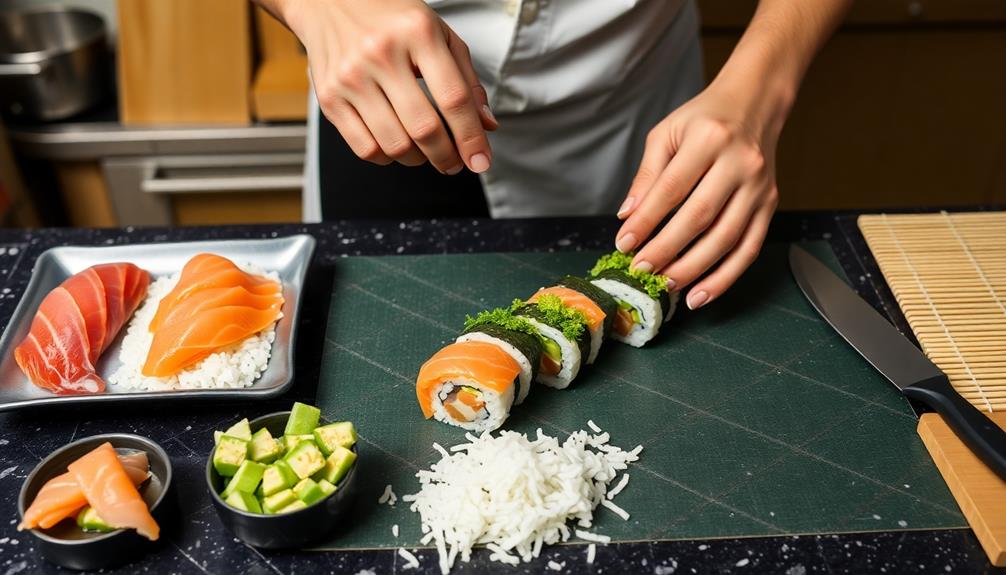
To make authentic sushi at home, you'll first need to gather fresh sushi-grade ingredients.
Then, you'll perfectly roll the sushi using a bamboo mat, ensuring a tight and uniform shape.
Next, you'll slice the fish into thin pieces, creating the perfect bite-sized portions.
Step 1. Gather Fresh Sushi-Grade Ingredients
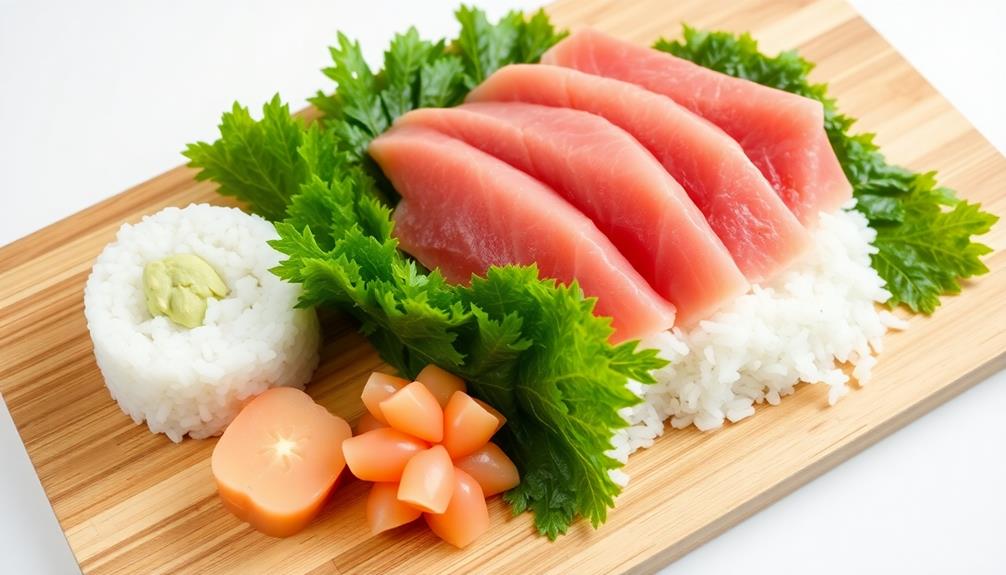
Obtaining fresh, sushi-grade ingredients is pivotal to crafting authentic sushi at home. Seek out a reputable local fishmonger or Asian grocery store to source the highest quality, sushi-grade fish.
Look for tuna, salmon, yellowtail, and other popular sushi varieties that are bright in color, firm to the touch, and free of any discoloration or strong odors.
In addition to fish, you'll need short-grain Japanese rice, rice vinegar, sugar, and salt to prepare the sushi rice.
Opt for nori seaweed sheets, a bamboo sushi mat, a sharp knife, and other essential tools. Consider adding avocado, cucumber, and other fresh produce to complement your sushi fillings.
Carefully inspect all ingredients, verifying their freshness and suitability for sushi preparation.
Handling sushi-grade foods with care is crucial to ensuring food safety and preserving the delicate flavors.
With the right ingredients on hand, you're well on your way to crafting restaurant-quality sushi at home. All it takes is a bit of preparation and attention to detail to roll up sushi that looks and tastes just like your favorite eatery’s. While sushi may seem intimidating at first, following a step-by-step guide can make the entire process enjoyable and rewarding. And if you’re feeling extra ambitious, why not explore an authentic tortillas recipe to complement your culinary adventure with another homemade delight?
Step 2. Perfectly Roll Sushi Using a Bamboo Mat
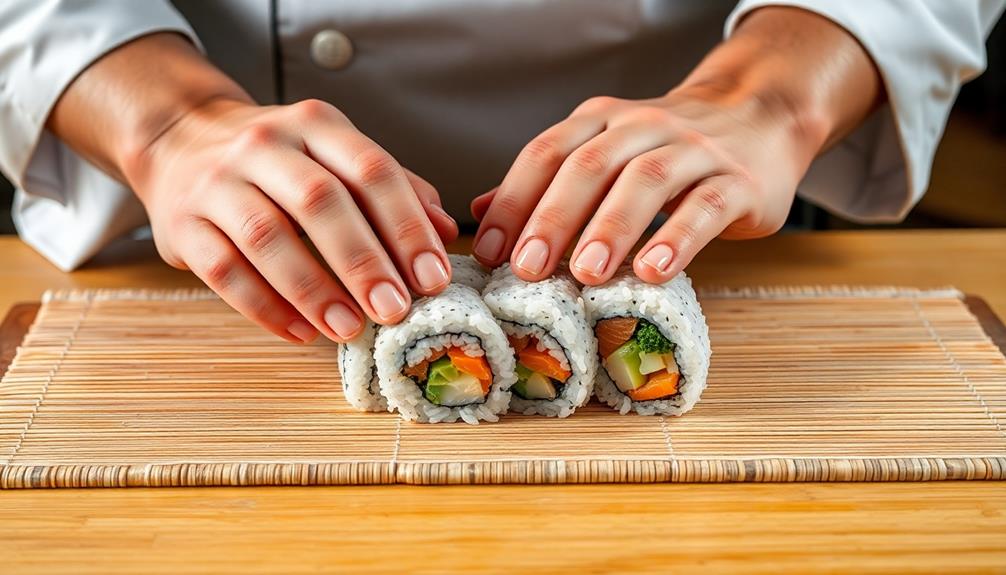
Carefully place the bamboo sushi mat on a clean, flat surface. Lightly moisten the mat with a damp cloth to prevent the rice from sticking.
Take a portion of sushi rice and spread it evenly over the center of the mat, leaving a 1-inch border at the top. Gently press the rice into the mat, shaping it into a flat, rectangular layer.
Next, place your choice of sushi fillings, such as thinly sliced fish, vegetables, or cooked shrimp, in a line across the rice. Be mindful not to overstuff the roll.
Grasping the bottom edge of the mat, slowly roll it up and over the fillings, applying gentle pressure to shape the roll. Continue rolling until the sushi is fully wrapped. Moisten the exposed rice with a little water to help seal the roll.
Using a sharp, wet knife, slice the sushi roll into 6-8 even pieces. Serve with soy sauce, wasabi, and pickled ginger for the authentic sushi experience.
Step 3. Slice Fish Into Thin Pieces
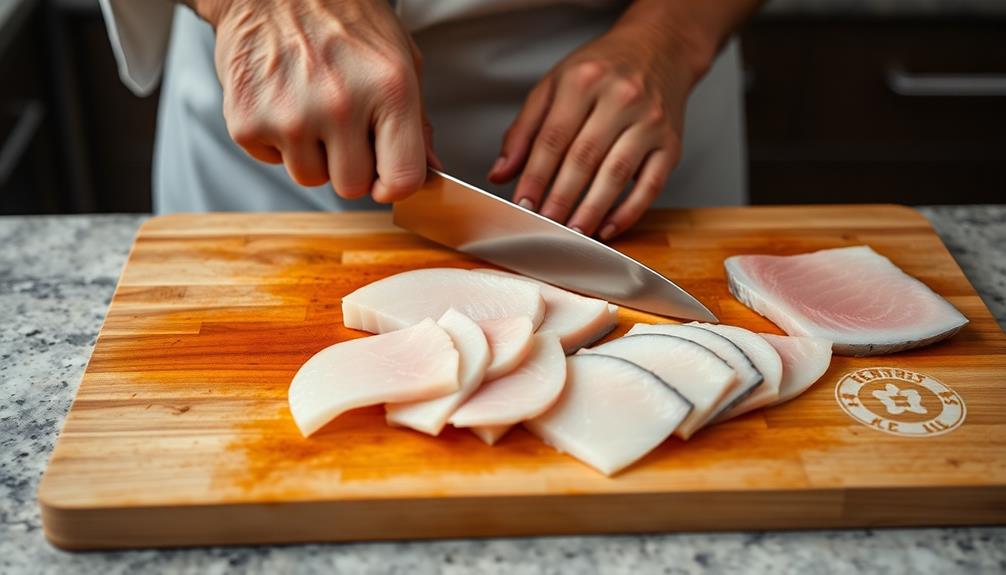
Across a clean cutting board, position the fresh fish fillet. Using a sharp, high-quality knife, begin slicing the fish into thin, uniform pieces.
Gently press down on the blade as you slice, maintaining a steady, controlled motion. Aim for slices that are approximately 1/4-inch thick, ensuring they're thin enough to melt in your mouth but not so delicate that they fall apart.
As you slice, keep the knife angled slightly to achieve that classic sashimi-style shape. Periodically check the thickness, adjusting your technique as needed.
Slice against the grain of the fish for the most tender texture. Once you've portioned the entire fillet, arrange the sashimi slices neatly on a serving platter.
Step 4. Serve Sushi With Soy Sauce
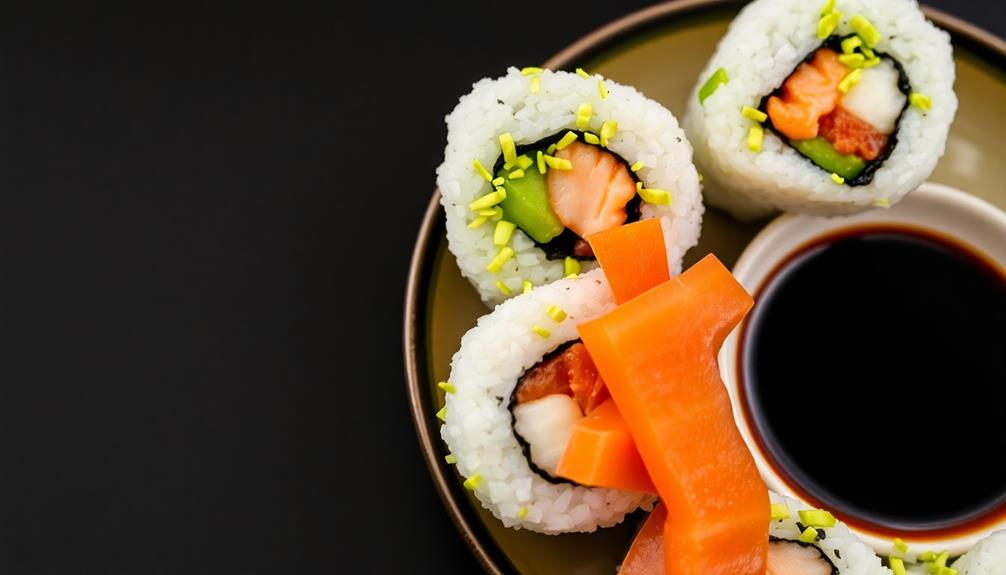
With the sashimi beautifully presented, it's time to enhance the flavors. Soy sauce is the classic accompaniment for sushi, adding a savory depth that complements the fresh fish.
Encourage your guests to drizzle a small amount of soy sauce directly onto the sashimi, using the sauce sparingly to avoid overpowering the delicate flavors.
For a more traditional experience, serve the soy sauce in a small dipping dish, or ramekin, alongside the sushi plate. This allows your guests to control the amount of sauce they use, dipping each piece individually.
You may also wish to provide:
- Wasabi – The fiery green paste that can be mixed with a bit of soy sauce for a bolder flavor.
- Pickled ginger – The pale pink slices cleanse the palate between bites, preparing the taste buds for the next piece of sushi.
With these classic accompaniments, your guests can customize their sushi experience to their personal preferences, enhancing the authentic flavors of your homemade sushi.
Step 5. Garnish Sushi With Pickled Ginger
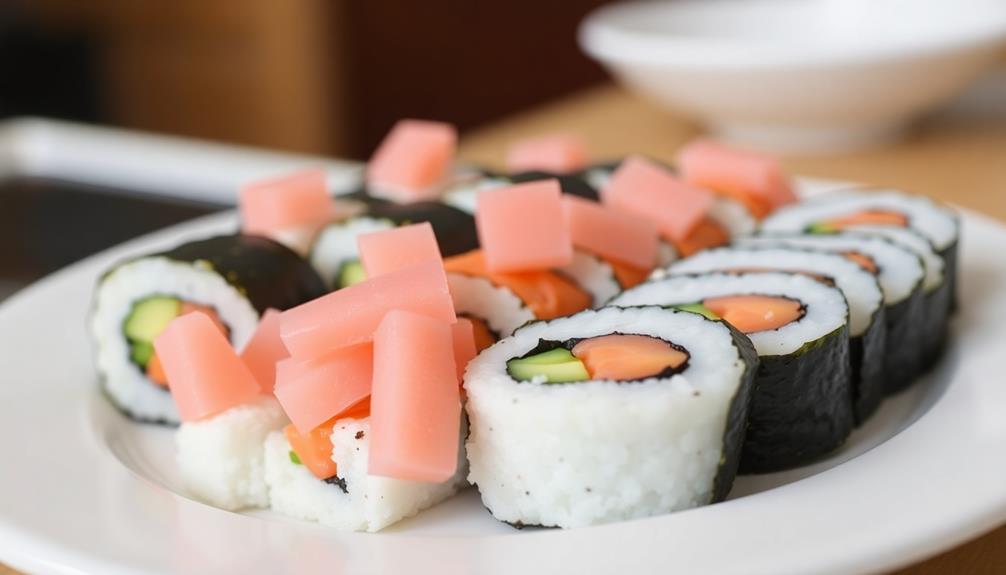
Pickled ginger, with its pale pink hue and tangy-sweet flavor, complements the fresh sushi beautifully. It's a common garnish that adds a refreshing contrast to the rich, umami-packed sushi.
To prepare pickled ginger, start by thinly slicing fresh ginger root. Soak the sliced ginger in a mixture of rice vinegar, sugar, and salt. The acidic vinegar softens the ginger's spiciness, while the sugar balances it with sweetness.
Let the mixture sit for at least 30 minutes, stirring occasionally, until the ginger has a translucent, vibrant pink appearance.
Drain the pickled ginger and place it in a small dish on the side of your sushi plate. Encourage your guests to take a bite of the ginger between sushi pieces to cleanse their palates and prepare for the next flavor-packed bite.
The ginger's zesty kick will help stimulate the senses and enhance the overall sushi experience.
Final Thoughts

Mastering the art of authentic sushi at home may seem daunting, but with the right techniques and guidance, you can elevate your culinary skills and impress your guests.
While the journey of crafting sushi from scratch may seem intimidating, the rewards of savoring the fresh, flavorful results are well worth the effort.
Remember, sushi-making is a delicate balance of precision and artistry. Pay close attention to the quality of your ingredients, the sharpness of your knives, and the temperature of your rice. The rice should be seasoned just right, striking the perfect balance between sweet, salty, and tangy. By consistently monitoring the heat and moisture levels, you can achieve perfect sushi rice every time. Finally, be patient and deliberate in your technique; rushing the process can compromise both flavor and presentation. Additionally, practice makes perfect, so don’t be discouraged if your first attempts aren’t exactly what you envisioned. Follow a *perfect sushi rice recipe* and adjust it based on your taste and the specific ingredients you’re working with. Over time, you’ll develop a personal rhythm that allows you to craft sushi that is as visually stunning as it is delicious.
Experiment with different flavor combinations, and don't be afraid to get creative.
As you continue to hone your sushi-making skills, take pride in the dishes you create. Sharing authentic sushi with loved ones is a truly special experience that celebrates the rich culinary traditions of Japan.
Embrace the process, enjoy the journey, and savor every bite. With practice and passion, you'll be crafting sushi masterpieces in no time.
Frequently Asked Questions
What Type of Rice Is Best for Making Sushi?
The best type of rice for making sushi is short-grain Japanese rice. It's sticky, tender, and has the perfect texture to hold the shape of the sushi roll. You'll want to use a high-quality, sushi-grade rice for the most authentic taste.
How Long Can Homemade Sushi Be Stored?
Homemade sushi can be stored for up to 24 hours in the refrigerator. However, it's best to consume it within the first 12 hours for optimal freshness and flavor. Storing it any longer may compromise the texture and taste.
Do I Need Special Equipment to Make Sushi at Home?
You don't need any special equipment to make sushi at home. A sharp knife, bamboo mat, and a few other basic tools are all you need to create delicious sushi right in your own kitchen.
How Do I Achieve the Perfect Sushi Rice Texture?
To achieve the perfect sushi rice texture, you'll need to rinse the rice thoroughly, cook it with the right water-to-rice ratio, and season it with rice vinegar, sugar, and salt while it's still hot.
What Are Some Common Mistakes to Avoid When Making Sushi?
When making sushi, avoid common mistakes like overpacking the rice, using the wrong type of rice, not seasoning the rice properly, and cutting the fish sloppily. Pay attention to detail, and you'll create delicious sushi at home.
